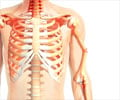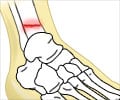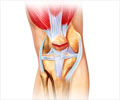Novel drug for treating bone fractures has been developed. Following injection, the drug targets the fracture site and accelerates the healing process. This results in a rapid increase in bone density.
- A novel drug has been developed for treating bone fractures
- The drug is a conjugate of an existing anti-cancer drug with the amino acid aspartic acid to synthesize dasatinib-aspartate10-conjugate (DAC)
- When the drug is injected intravenously, it localizes at the fracture site. It accelerates the healing process, reduces the recovery time and rapidly increases bone density
- This novel strategy could be a major breakthrough and a paradigm shift in the way bone fractures are treated
Read More..
New Drug that could be a Game Changer
A new study has revealed the potential of a novel bone anabolic agent for accelerating the healing of fractures. The drug, when injected into the blood can reduce the healing time of femur fractures by 60%, without causing any harm to adjacent tissues. The study, entitled, “Bone fracture-targeted dasatinib conjugate potently enhances fracture repair in vivo”, has been presented at the 2018 American Association of Pharmaceutical Scientists (AAPS) PharmSci 360 Meeting, held on 4-7 November, 2018 at the Walter E. Washington Convention Center, Washington, DC, USA.How Does the New Drug Work?
Scientists at the Purdue Institute for Drug Discovery, Purdue University, West Lafayette, Indiana, USA have developed this novel drug. They have used an existing anti-cancer drug, dasatinib and chemically attached the amino acid aspartic acid to synthesize dasatinib-aspartate10-conjugate (DAC). This new drug has been found to promote the growth of new bone tissue.When injected intravenously, the drug is targeted to the fracture site and accelerates the repair of the bone and increases the bone density. While it normally takes around 8 weeks for a fracture to completely heal; with this new drug, the time can be reduced to 3-4 weeks.
Mingding Wang, PhD Candidate at the Purdue Institute for Drug Discovery and the presenting author, said: “We foresee a significant need for this type of therapy.” “Even though many broken bones don’t need surgery, most require a prolonged healing process that can lead to morbidity, loss of work productivity, and in some cases even death. By developing a therapy that can accelerate bone fracture repair without damaging healthy bones or tissues, we can hopefully address these critical issues.”
Study Findings
The study found that administration of DAC on alternate days for 3 weeks was equally as effective as administering the drug every day, which increased the bone density by a staggering 114%. This alternate-day approach was found to be the most effective treatment regimen. However, if the drug was administered every 4 days, the clinical efficacy of DAC decreased appreciably.It is well established that the blood supply in the vicinity of a fracture is disrupted soon after it occurs. The study found that if DAC administration was delayed for a couple of weeks in order to give a chance for the blood vessels to regenerate at the fracture site, there was no negative impact on the drug’s efficacy or the time required for complete healing.
It was also found that when dasatinib was administered alone, there was only a marginal improvement in fracture healing, since this drug is non-targeted. However, when DAC was administered, there was a dramatic improvement in healing, with a doubling of bone density. This arose from the fact that DAC directly targets the fracture site. Moreover, since dasatinib itself is not significantly toxic when used in chronic cancer patients, it is quite plausible that its targeted form (DAC) would be much less toxic as it would be concentrated at the fracture site, without harming other healthy tissues in the body.
Expert Opinion
Professor Philip S. Low, Ralph C. Corley Distinguished Professor of Chemistry and Director of the Purdue Institute for Drug Discovery and also the Principal Investigator of the study, said: “While the use of casts, rods, or pins may still be required in some cases, the ability of this therapy to accelerate the return of a fracture patient to normal function and lifestyle could have widespread benefits to the entire orthopedic community.”Future Plans
The research team plans to investigate the efficacy of DAC in other types of fractures such as long-bone fractures, hip fractures, craniofacial fractures, nonunion fractures, and spinal fusions.References:
- AAPS Press Room - (https://www.aaps.org/news/for-media/press-room)
- Fracture Epidemiology - (https://www.capturethefracture.org/fracture-epidemiology)
Source-Medindia















